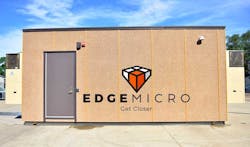EdgeMicro Deploying 5 Sites in Next Phase of Edge Network
Edge computing specialist EdgeMicro has shifted into active development, with data center construction projects underway in five new markets, the company said last week. The company is bringing modular deployments to Cleveland, Indianapolis, Memphis, Houston, and Pittsburgh. The sites are slated to come online before the end of 2020.
The new locations build upon the company’s three initial installations in Austin, Tampa and Raleigh. EdgeMicro founder and CEO Mike Hagan said the next round of sites are underserved markets with a strong population base, and were driven by customer requirements.
“Success of our initial locations has accelerated our deployment to the edge,” said Hagan. “Our portfolio of eight strategically positioned MDCs (micro data centers) offer businesses the chance to connect to users and fully demonstrates our ability to scale in a rapidly growing edge market. By offering infrastructure closer to the end user, we lower latency and positively impact the bandwidth challenges that have been created by increasingly important work-from-home demands related to the COVID-19 pandemic.”
Edge Micro envisions a future in which thousands of small modular data centers provide multi-tenant colocation, bridging the infrastructure gap between data networks and mobile devices. The company was founded in 2017 announcing ambitious plans to roll out 500 data centers by 2021. The edge computing market has developed more slowly than anticipated by EdgeMicro and other startups targeting this niche, but the new round of customer-driven deployments suggests that edge demand is picking up.
“Due to our expanding portfolio we are experiencing heightened leasing activity,” said Jason Bourg, EdgeMicro Vice President of Revenue. “EdgeMicro’s ability to deliver reliable, repeatable, colocation and connectivity is paying off for both our business partners and the mutual customers we serve.”
“The objective of our anchor customers is to distribute content to the edge,” said Lauri Abrahamson, Director of Business Development at EdgeMicro. “That’s the immediate project for this year. It’s taken a lot of effort to get the players together – the cable providers and fiber providers.”
Abrahamson joined the EdgeMicro team in May following a $5 million funding round lined up by DH Capital, which enabled the company to add staff and begin construction. It previously raised $3 million in early 2019.
Evolving Along With Customer Strategies
The company’s vision for edge computing evolved as customers identified network priorities. Hagan discussed the company’s process with Data Center Frontier in 2019.
“When we started out, we all focused on towers,” said Hagan. “What our customers expressed to us is that these sites often didn’t have enough connectivity. We focused on finding a fiber aggregation point that can connect both upstream and downstream traffic. It was harder than anyone in the industry expected. Towers are still in our portfolio, but we revamped our strategy, and that’s why.
“The reality is that 70 percent of the population lives outside the 30 major cities,” Hagan added. “We all know there’s a market here. You can’t solve the distance problem any way but moving content closer and more connected. A lot of (customers) have been working on their strategy. Not everything is latency sensitive, and there’s a lot of hype in the industry. But we’ll all work together to solve this for a better consumer experience.”
A challenge for customers has been sorting out the many different takes on edge computing, including where it will live and the best ways it can help them (for more on this, see Layers and Location of Edge Computing and Edge Computing Use Cases).
“Everyone has a different view of what edge is,” said Hagan. “We’re not naive that the edge means lots of different things. What we’ve done in planning with our real estate partners is lease enough land for our first unit, and put in ROFOs (right of first offer) in place for units two, three and four. We built this whole model with input from every colocation provider we know.”
In January we noted that the “economics of edge computing will come into sharp relief in 2020, as end users and investors will focus on near-term cost/benefit analyses rather than long-term potential.” For more, check out our annual forecast, Eight Trends That Will Shape the Data Center Industry in 2020.
About the Author



